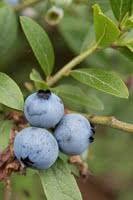Mon-Fri 9am - 5pm Mountain time
Blue Treasure Haskap (Honeyberry) vs Lowbush Blueberry
Vaccinium angustifolium
Lonicera caerulea Blue Treasure
NOT AVAILABLE THIS SEASON - MIGHT RETURN
Lowbush Blueberry, commonly known as the Wild Lowbush Blueberry, is often wild-harvested and thrives in low pH acidic soil. This early low-bush blueberry produces white and pink bell-shaped flowers in the spring. Its fruit is smaller in size than high bush blueberry plants and is more flavourful with an intense blueberry taste-masking it perfect for fresh eating, baking, and preserves.
Note: Blueberries require very specific soil conditions. They need well-drained soil with a pH between 4.5 and 5.0. If the starting pH of your soil is between 5.1 and 6.2 you can lower it by adding sulfur. We recommend against planting blueberries in soil with a starting pH greater than 6.2. Please do your own research before buying any blueberry plants.
Blue Treasure Haskap is a late season cultivar, ideal for cooler climates, and a favorite from Berries Unlimited. The berries are delectably sweet and ideal for fresh eating, but can also be made into jam, juice, and wine.
Blue Treasure is a late pollinating variety. Pair with other late pollinators to have a higher yield.
Kawai is a great companion variety.

